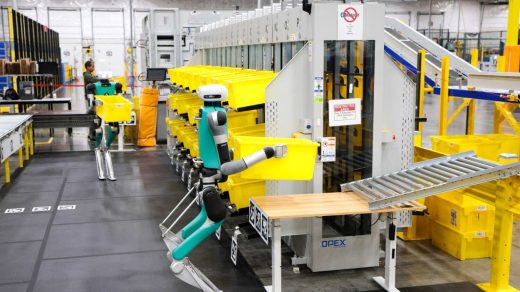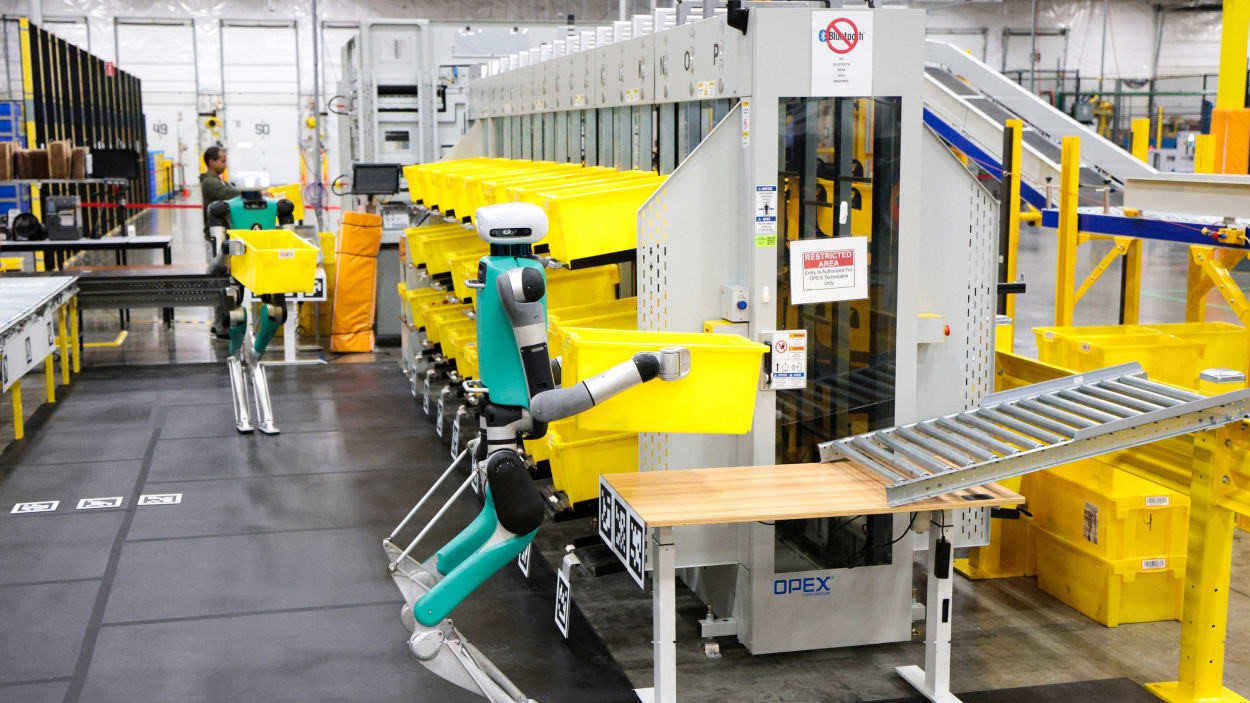Amazon has new AI-powered robots. Labor leader Chris Smalls says unions could protect workers
In recent weeks, Amazon announced that its warehouses are starting to adopt new robotic arms and sorting machines fueled by artificial intelligence, starting with a fulfillment center in Houston. The retail giant says the new tech will help address safety issues for its workers, but its main objective is to boost productivity and shorten delivery times even further. Amazon claims its new robotics system can cut order fulfillment time by up to 25% and sort inventory up to 75% more quickly.
The introduction of robotics technology into warehouse operations—a shift mirrored by competitors like Walmart—is hardly new for Amazon, which has strived for years to create robotic arms on par with its human workers. But the latest development raises questions about the degree to which automation will impact, and eventually supplant, the hundreds of thousands of workers that keep Amazon’s warehouses running.
Amazon denies that the ultimate goal is to reduce head count. “We don’t see automation and robotics as vehicles for eliminating jobs,” Amazon spokesperson Mary Kate Paradis tells Fast Company in a statement. “Our workforce has more than doubled in size since the beginning of 2019, growing to over 1.5 million people globally—all while we’ve expanded the use of robotics in our operations facilities.”
But to Chris Smalls, president of the Amazon Labor Union, it seems inevitable that Amazon may eventually use the new technology to cut jobs, even if it won’t happen overnight. “It’s expected—I know they were always pushing toward that direction,” he says. “Even though they made this announcement, I believe they’re still a ways away from [full automation]. It would be pretty difficult to massively swap out the workforce that they have.”
Smalls believes that Amazon’s push for automation is a major reason why unionizing warehouse workers is so crucial, especially amid high rates of injury and turnover. “If they can create a [system] where the machinery is helping reduce injuries, I support it,” he says. “Replacing jobs? Not so much. I just hope to see that these jobs are unionized and they have some say in how the AI and technology is being incorporated.”
But Smalls knows all too well unionizing workers at Amazon can be easier said than done. In 2022, organizers scored a historic win when workers at the Staten Island warehouse voted in favor of joining the Amazon Labor Union, marking the first time an Amazon facility in the U.S. had successfully unionized. Prior to that, a high-profile union drive at an Amazon warehouse in Bessemer, Alabama, had resulted in workers voting against unionization—twice. In California, Amazon drivers who managed to unionize with the Teamsters and secure a union contract were then fired, sparking a months-long strike over unfair labor practices that has since spread across the country. (Unlike warehouse workers, however, the drivers are technically employed by one of Amazon’s delivery-service partners.)
Over the past 18 months, the Amazon Labor Union has found itself mired in legal battles. Within a week of the Staten Island election to unionize, Amazon had filed a complaint with 25 objections to overturn the election results. The case was rejected by the National Labor Relations Board (NLRB) in January, when the agency officially certified the union. Since then, Amazon has continued to appeal the decision and refused to begin contract negotiations, forcing the chronically underfunded NLRB to lodge a formal complaint that the company is flouting U.S. labor laws—which many argue are weak to begin with. “We strongly disagree with the outcome of the election, and as we showed throughout the JFK8 Objections Hearing with dozens of witnesses and hundreds of pages of documents, both the NLRB and the ALU improperly influenced the outcome, and we don’t believe it represents what the majority of our team wants,” says Paradis.
All this might sow doubt about the union’s ability to tip the balance of power at a company like Amazon. The union has also lost two other elections in the time since its major victory in Staten Island, leading some people to question whether Smalls can deliver on his bold promises to unionize other Amazon workers and deliver meaningful changes to their working conditions. Smalls says the union has continued to engage with members through demonstrations and regular outreach; the group also helped draft the Warehouse Worker Protection Act, which was signed into law in New York last year and sought to address the issue of work quotas at Amazon and other companies that employ warehouse workers. But without a contract, the union can’t secure concrete protections for workers who get injured, or those whose jobs might be compromised in the near future by the use of robots.
And as the fight with Amazon has dragged on, the union has also faced discord within its own ranks. In July, a reform group within the union filed a lawsuit to force a leadership election, reportedly due to frustrations over how Smalls was steering the ship—namely, his decision to continue organizing other warehouses and holding elections while waiting on a contract for the Staten Island warehouse. (The lawsuit was derailed soon after by a judge’s ruling that more or less urged the union to “work this out yourselves.”) “It only gives Amazon ammunition to say that the union is not together,” Smalls says of the infighting. “But fortunately for us, the people who are raising concerns about elections are a small handful.”
Smalls insists the union is keeping the pressure on Amazon to negotiate a contract. While he isn’t pushing for a strike at the moment due to budgetary concerns, it’s not out of the question if the union’s financial position changes. “A strike costs money, and unfortunately we don’t have it,” he says. “We’re just the worker-led independent union right now that’s in startup mode. But hopefully one day, there will be enough money in the bank where we can call the strike. Keep in mind we have 8,300-plus members, and I don’t think Amazon is going to come to the table in one day.”
At the same time, Smalls also believes that organizing other warehouses could help force Amazon to the table—and perhaps even influence the NLRB’s interpretation of labor law. “We need better laws, and we’re hoping that our organizing is going to open up the doors for that,” he says. “Unions used to organize in secrecy before they would go public with a lot of their campaigns. We’ve done things backwards, so to speak. We’re more vocal. We’re putting the company out there on blast, using social media as a weapon, and showing the true ugliness of the company.”
To Smalls, eliminating the human touch—whether that means replacing workers with robots or reducing workers to their productivity quotas—is as ugly as it gets.
(10)



